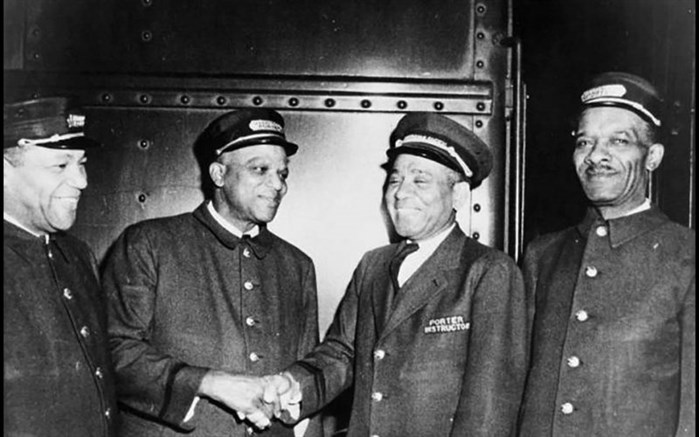
Porter instructors trained other porters for nearly 100 years.
Image Credit: SUBMITTED
June 16, 2025 - 12:00 PM
OPINION
Forty years ago, I moved to Washington, D.C. from Wilmington, DE, and started looking for a home. I worked in the U.S. capital the first time nearly 50 years ago, when I was 25 years old…choosing then to live in a fashionable suburb…Reston, VA.
This second time, I was 35 years old…married…with no children…and chose urban rather than suburban life. I hated commuting…for me a waste of time in every sense. I wanted to live on Capitol Hill…the seat of the U.S. government…even though my advertising and public relations firm focused on corporate not government clients.
The Hill had a lively feel. The U.S. Supreme Court called it home…and eventually I chose a three-level townhome with a rooftop deck complete with a view of both the nation’s Capitol dome and the highest court in the land.
I looked at probably two dozen places seeking my new home. One of the places I considered was on Massachusetts Avenue…on Capitol Hill and within sight of Union Station…the cavernous city train depot for more than 100 years.

(DON THOMPSON / iNFOnews.ca)
Originally built as a townhouse in the 1880s, it was bought by The Brotherhood of Sleeping Car Porters in the early 20th century and turned into a boarding house for porters laying over between trains heading North, South and West.
The townhouse exterior still held its 19th century charm…a beautiful red-stone Beaux Arts building. Inside, it resembled little of that or any other style…it was utilitarian at best. There was a kitchen, a single bath…with the once stately parlour, drawing room, library and bedrooms had been carved into perhaps a dozen rooms.
Before planes…most wealthy Americans and Canadians travelled by train in the late 19th through the mid-20th century. Sleeping cars afforded well-heeled travellers the comfort and convenience of a rolling hotel room. The highest-end sleepers had private toilets, showers, basins with a mirror, a sitting area that converted to two sleeper births.
Virtually all of the sleeping cars in the U.S. were owned by George Pullman. At the height of luxury train travel in the 1930s, Pullman employed more than 20,000 Black men…the largest employer of black men in America. Porters served every need and whim of passengers…from setting up berths and carrying luggage to serving food and drinks and shining shoes.
Porters wore Grey caps and dark grey or black coats, grey slacks, white shirts and black ties. Shoes were shined. There was a military-like appearance and discipline…and they could be fired for not looking presentable. Porters paid for their own uniforms and shoes despite low pay. Tips from passengers made the difference in their lives…a quarter at a time.
Actually, nothing much was out of bounds if a wealthy paying customer asked. Sick children…porters looked after them. Drunk passengers…porters took care of them. I remember the porters on trains I took in the late 1950s and 1960s. They called every passenger Sir or Madam. Some treated porters with respect…but most imposed an almost master-slave relationship.
Typically, porter duties lasted 48 to 72 hours. There were no sleeping quarters on trains for porters. They took naps when and where they could…usually on a drop down seat in an otherwise unused car.
When I toured the property on Massachusetts Avenue I was considering re-converting it to a townhouse…there were still three rooms being used by porters working runs into and out of D.C.’s Union Station. I asked one of the porters about their work…his name was Booker, as I recall. He was retiring later that week after 38 years of riding the rails…he had started his career before I was born.
He said life improved slowly during those decades. Most people called all porters “George” from the 1920s to 1960s, he told me…a way of keeping them in their place, he added. Only the porters called their fellow porters by their given names.
Booker didn’t sound bitter. He was glad, he said, to have a job…it was hard work…but you dressed nice and it wasn’t work in the fields. Thousands raised families…put kids through college.
Porters worked in Canada, as well, and quite frankly life was no better. Indeed, a nationwide union formed in Canada several years after the U.S. While what is now Canada served as home to Black enslaved folks from the U.S. in the early and mid-1800s, those who became porters in Canada were for the most part treated as second-class citizens.
Black people were considered socially inferior to whites and menial work, such as that of sleeping car porters, was one of the only jobs they could get…even though many had college degrees.
I called the few porters I came in contact with…Sir. There was usually a wry smile…almost like they knew…however late coming…that times would change…things would soon be different for them and their children.
— Don Thompson, an American awaiting Canadian citizenship, lives in Vernon and in Florida. In a career that spans more than 40 years, Don has been a working journalist, a speechwriter and the CEO of an advertising and public relations firm. A passionate and compassionate man, he loves the written word as much as fine dinners with great wines.
We welcome your comments and opinions on our stories but play nice. We won't censor or delete comments unless they contain off-topic statements or links, unnecessary vulgarity, false facts, spam or obviously fake profiles. If you have any concerns about what you see in comments, email the editor.
News from © iNFOnews, 2025